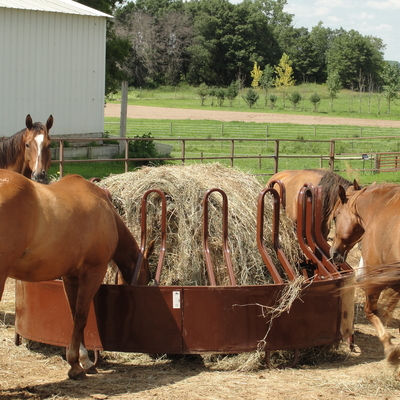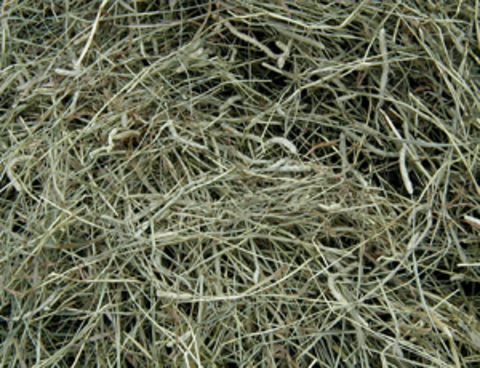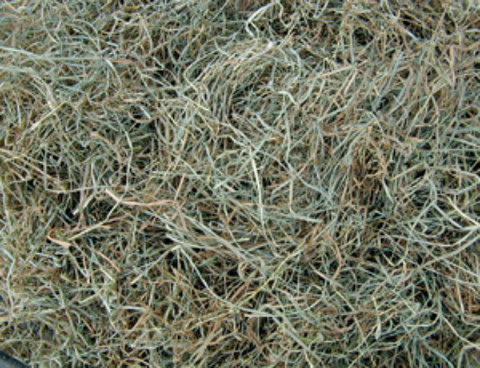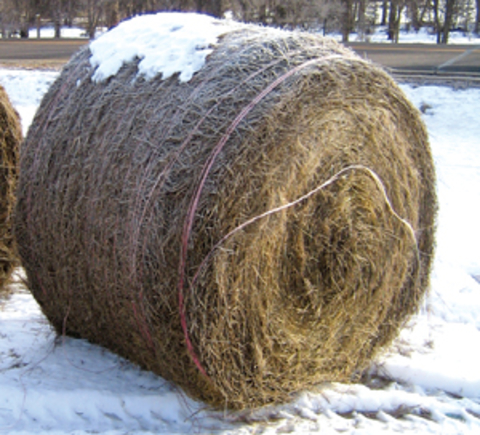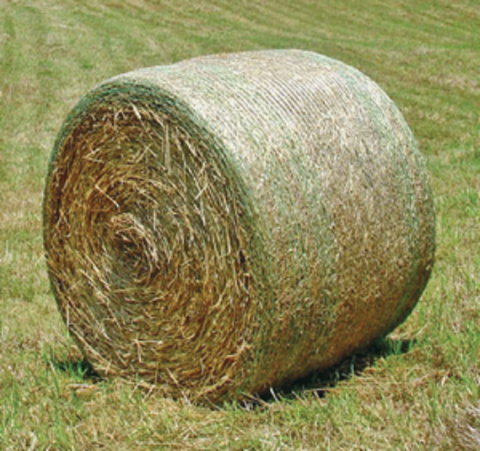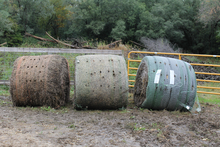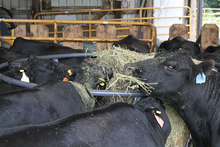Quick facts
- Plants have more fiber and less protein as they mature.
- All hay needs mineral and vitamin supplementation.
- You can feed quality, rained-on hay to horses.
- Horse quality hay should be baled between 10 and 15 percent moisture.
- Store and protect hay from moisture to best prevent spoilage.
- Bale-wrapping research found B-Wrap® is better than twine and net wrap in shedding moisture when storing hay outdoors for long periods.
Horses efficiently digest forages, and most horses can fulfill their nutrient requirements on these types of diets.
You should choose your forage based on your horse’s nutrient needs and consider plant species and maturity when making a decision about what to feed your horse.
Forage species
Legumes and cool-season grasses are common horse forages. Know what percent grass and legumes are in your hay before buying it.
Legumes include alfalfas and clovers. They generally produce a higher quality forage than cool-season grasses when baled at the same growth stage. Compared to grasses legumes are,
-
Higher in energy
-
Higher in protein
-
Higher in minerals (calcium)
-
Lower in nonstructural carbohydrates (starches and sugars)
-
Usually more palatable
-
Usually more digestible
Legumes provide horses an excellent source of nutrients, but feeding pure or immature legumes can easily exceed a horse’s nutrient needs. Excess nutrients can lead to obesity. Legume-grass mixes or mid- to late-maturity legumes (less nutrient-dense) often provide adequate nutrients, without exceeding the horse's needs.
Alfalfa has more protein than grasses, which is highest in the leaves. As the plant matures, the protein content declines. Excess protein doesn’t affect the horse’s health but will increase their water needs. Thus, horses will urinate more and excrete more ammonia.
Some legumes are hard to dry (like red clover) when making hay, and thus have a higher risk of molding.
Cool-season grasses are grasses that thrive in cooler, wetter climates. They are popular in the Midwest and grow best in the spring and fall. The following are common cool-season grasses found in horse hay and pastures:
-
Orchardgrass
-
Bromegrass
-
Timothy
-
Fescue
-
Reed canarygrass
-
Kentucky Bluegrass
Compared to legumes, grasses are
-
Lower in protein.
-
Lower in calcium.
-
Less calorie dense.
-
Higher in nonstructural carbohydrates.
General nutrient characteristics of forages commonly fed to horses
| Nutrient | Cool-season grasses | Legumes |
|---|---|---|
| Digestible energy (Mcal/kg) | 1.7-2.5 | 2-2.5 |
| Crude protein (%) | 6-18 | 14-26 |
| Neutral detergent fiber* (%) | 55-65 | 35-45 |
| Acid detergent fiber** (%) | 30-40 | 30-40 |
| Calcium (%) | 0.2-0.5 | 0.8-1.5 |
| Phosphorus (%) | 0.2-0.4 | 0.2-0.3 |
*Neutral detergent fiber relates to palatability (lower value indicates more palatable)
**Acid detergent fiber relates to digestibility (lower value indicates more digestible)
Factors for choosing hay
Consider having your hay tested to determine the contents of hay such as:
Moisture
Protein
Minerals
Sugar
Energy
Be sure to request an equine analysis and remember that the analysis is only as good as the sample you submit.
The maturity of a plant affects forage quality. Young, immature plants are nutrient dense and contain less fiber. As the plant matures, the proportion of fiber in the plant increases. This can decrease plant digestibility.
Most horses do well on mid-maturity forages. Horses that require higher nutrient needs (e.g. lactating mares) benefit from young, less mature forages. More mature forages are a good choice for easy keepers.
The following indicate a more mature plant:
-
Flowers in legumes.
-
Seed heads in grasses.
-
Thick stems.
Grasses harvested just as the seed heads start to form have excellent fiber digestibility and energy availability, and will produce leafy hay.
The leaf to stem ratio of a plant is also key. As a plant matures the leaf to stem ratio declines. Compared to stems, leaves have
-
More protein.
-
More digestible energy.
-
Less fiber than stems.
Cutting
- The cutting (1st, 2nd or 3rd crop) doesn’t predict the hay’s nutrient content.
- Maturity at the time of cutting is the basis of the hay’s nutritional value.
- Plants that grow under cooler temperatures build more digestible fiber.
- First crop hay may have more and easier to digest fiber.
Mouth feel
A horse’s mouth, lips and tongue are very soft. Thus, they will be more willing to eat softer hay and in turn, waste less. Even if the hay has good nutritional value, it must be appealing to the horse otherwise they’ll waste it.
Smell
Sweet smelling hay is appealing to people and horses and indicates available energy (sugar). A sweet smell is an incentive for the horse to eat the hay and get its full nutritional value.
- Green is appealing to horse owners and indicates the presence of vitamin A.
- Bleached color indicates exposure to sunlight or rain. In this case, vitamin A content is lower, but other essential nutrients still remain.
- Despite the color, you must supplement any hay with an appropriate vitamin-mineral mix.
- Don’t be too concerned about color. Remember, weeds are also green.
Rained-on hay
You can feed quality rained-on hay to horses.
- Hay quality declines the most when rain occurs after the forage has partially dried.
- Alfalfa dry matter declined 22 percent when exposed to an inch of rain after one day of drying.
- Similar hay without rain damage lost only 6.3 percent.
- Rain (or soaking hay in water) can reduce the nonstructural carbohydrate (sugar) content of the hay.
- Good quality, rained-on hay can benefit horses that are sensitive to forage sugar content.
Learn more about determining the value of rained-on hay.
Moisture
Horse quality hay should be baled between 10 and 15 percent moisture.
- Hay baled at over 17 percent moisture is at risk of molding.
- Hay baled over 25 percent is at risk of severe heat damage and serves as a potential fire hazard.
Preservatives are commonly used during times of frequent rainfall or poor drying conditions (high humidity or heavy dew). Propionic and acetic acids are commonly used hay preservatives that are applied to hay as it is baled to allow baling of slightly wetter than normal hay with a reduced chance of mold formation during storage.
Moisture at the time of baling is directly related to mold formation.
- Hay baled at 15 percent or less moisture is unlikely to mold. This is impacted by bale-type and mass.
- Small square bales can be baled at up to 17 percent moisture with a limited risk of mold formation.
- Large round bales must be baled at 15 percent or less moisture to reduce the risk of mold formation.
- Preservatives are most effective at inhibiting mold growth and most economical when they are applied to hay baled between 17 to 22 percent moisture.
In separate studies, researchers from Cornell University and the University of Illinois found that when given a choice, horses preferred hay that was not treated with a preservative over hay that had been treated with a preservative. But horses readily consumed the treated hay when they didn't have a choice.
Yearlings fed hay treated with a preservative had similar intakes and weight gains during the trial period compared to yearlings consuming untreated hay. Clinical measures of the yearling’s well-being were not affected by consumption of preservative-treated hay, indicating the preservative had no negative effects on the horses.
Interestingly, a horse’s hindgut bacteria actually makes propionic acid as a result of microbial fermentation. Researchers agree that feeding horses hay treated with preservatives is a safe and common practice, especially when poor weather conditions exist for making dry hay.
Mold
Don’t feed horses moldy hay.
- Nearly all feed has some mold spores.
- Excessive mold may cause coughing, heaves or allergic reactions if horses inhale it.
- Horses with heaves are often more sensitive to mold spores or dust.
- Always inspect the inside of at least one bale before buying the hay.
- Hay stored inside that isn’t already moldy has a low risk of getting moldy.
Bale type
Hay can be baled in a variety of ways. Depending on your storage and feeding methods, each type has pros and cons.
Small square bales (40 to 80 pounds) are easy to handle and store. Horse owners commonly use this bale type. When fed and stored properly, small square bales usually have less waste than round bales and medium or large square bales.
Small square bales can be very labor intensive.
Horse owners also commonly use round bales (800 to 1,200 pounds). Due to their size, a tractor or skid steer is needed to move round bales.
Round bales can be less labor intensive than small square bales. But when stored improperly or fed without a feeder, round bales can result in excessive hay waste. Having enough horses (i.e. more than one) feeding off a round bale will reduce waste during feeding.
Medium or large square bales (800 to 1,200 pounds) gained popularity with horse owners over the past few years. They have the same pros and cons as round bales. But medium or large square bales tend to stack better and “flake” off easier for individual feeding than round bales.
Storage
Tips for storing hay to maintain good condition and reduce losses.
-
Don’t stack your hay under a leaky roof. It will grow moldier with each rain.
-
Plug rat and mouse holes.
-
Detour larger wildlife such as raccoons from moving in during the winter months.
Animals will make a mess of your hay storage by depositing feces and chewing through twine.
Droppings from some wildlife can cause diseases in horses like EPM (equine protozoal myeloencephalitis).
Stack bales on pallets to allow air flow under the bales and to help prevent the hay from absorbing ground moisture. Hay bales stored on wet surfaces can have as much as 50 percent spoilage.
Hay should keep indefinitely if:
-
Moisture can’t enter the bale from any direction
-
The hay was dry when put it into storage
High humidity can increase moisture content and reduce storage life. Thus, we recommend feeding hay within two years of purchase. Regardless, it’s good practice to always use older hay first.
Storing round bales end-to-end will reduce waste when stacked outdoors. Stacking large round bales usually increases losses, especially when stored outside. Stacking tends to trap moisture and limits drying from the sun and wind.
Outside storage loss for round bales ranges between 5 to 35 percent depending on:
-
The amount of precipitation.
-
Storage site location.
-
Original condition of the bale.
To reduce this loss:
-
Buy tightly packed bales.
-
They will sag less and make less contact with the ground.
-
-
Buy bales with net wrap.
-
They will resist weathering, insects and rodents better than natural twine fibers.
-
-
Store bales on a well-drained site (if outside).
-
Never store round bales under trees or in low lying areas.
-
Cover any bales you store outside. Tarps work well.
-
The outer 4-inch layer of a 6-foot diameter round bale contains about 25 percent of the total bale volume. This is subject to damage by weather without proper storage or cover.
-
A good plastic cover can reduce storage loss by one-half.
-
-
Storing round bales inside can reduce storage loss by about two-thirds.
Longevity of stored hay
| Hay Storage Options | Storage Longevity (Years) | Dry Matter Loss (%) |
|---|---|---|
| Conventional Shed | 20 | 4-7 |
| Tarped on Pallet | 5 | 4-7 |
| Net Wrap on Ground | 1 | 15-25 |
| Twine on Ground | 1 | 25-35 |
Summary
- If storing hay outdoors for more than 90 days, B-Wrap® (Ambraco Inc.) appears to be superior to twine and net wrap in shedding moisture, which helps preserve dry matter, forage quality and bale value.
- University of Minnesota research found using B-Wrap® resulted in lower mold counts and greater dry matter intake (DMI) when feeding beef cattle round bales that had been in long-term outdoor storage.
- Minimal forage quality differences between conventional and reduced-lignin alfalfa varieties were found after long-term, outdoor storage.
- Regardless of wrap type, the “weathered layer” of the bales did not exceed 6 inches, due to baling a solid, firm bale and storing on pallets.
Research method
- Conventional (12 bales) and reduced-lignin (12 bales) alfalfa hay was harvested in June 2017 in Minnesota.
- For both alfalfa varieties, groups of four round bales were wrapped with either plastic twine (Case IH), net wrap (Ambraco Inc.), or B-Wrap®.
- Bales were stored outdoors on wood pallets, on the rounded side, with approximately 5 inches between each bale.
- At the time of harvest and every 3 months for one year, individual bale weights were recorded.
- Stratified hay cores were taken from each bale including the outer 6 inches and the inner 6 to 18 inches.
Time to bind bales
Twine (56 seconds) required the most time to bind a bale, B-Wrap® (28 seconds) was intermediate, while net wrap (18 seconds) required the least amount of time. Time to bind each bale started when the tractor paused to wrap the bale and ended when the bale was ejected from the baler.
Alfalfa varieties
While alfalfa varieties did differ in neutral detergent fiber (NDF) and acid detergent lignin (ADL) at the time of baling, minimal differences were seen throughout the storage period, data were summarized across varieties. Minimal differences were observed in the inner 6 to 18 inches of the bales; therefore, only values of the outer 6 inches are discussed.
Dry matter losses
All bales began the storage period at a similar moisture.
- Starting on day 90, bales bound in twine and net wrap had a greater moisture concentration compared to bales bound in B-Wrap®.
- After one year in storage, the moisture concentration of B-Wrap® bales had not changed, while net wrap and twine bound bales had higher moisture concentrations (27%).
- Twine tied bales lost 7% DM, net wrap bales lost 5% DM, while B-Wrap® bales maintained DM.
- Maintaining DM is critical as that represents what farmers and livestock owners are harvesting, feeding, and buying or selling.
Forage quality
Changes in forage quality were observed at ≥180 days of storage with a dilution of nonstructural carbohydrate (NSC) and a concentration of insoluble fiber components including NDF and acid detergent fiber (ADF) due to moisture penetration in bales tied with twin or bound in net wrap.
- After one year, NSC, NDF digestibility at 48 hours (NDFD48), and relative feed value (RFV) were greater in B-Wrap® compared to twine tied bales, while net wrapped bales tended to be similar to both wrap types.
- B-Wrap® bales were lower in NDF and ADF concentration compared to twine tied bales.
Combined, these results indicate that B-Wrap® was better at shedding precipitation and inhibiting moisture penetration compared to the other wrap types. This is critical as moisture can dilute beneficial nutrients leading to a concentration of insoluble fiber values.
Economics
The cost of a wrap type is a common concern for producers.
- The estimated cost per large round bale when wrapped with B-Wrap® is $8.33, compared to net wrap and twine with estimated costs of $1.17 and $1.00 per bale, respectively.
- Bale value was calculated using bale weight, RFV ($1.28 per RFV point), the material costs of the wrap types in excesses of twine, and excluded round baler equipment costs and wrapping time.
- Starting at 180 days of storage, B-Wrap® bales had a greater individual bale value compared to net wrap and twine bound bales by ≥$10.84.
Feeding the bales to beef cattle
After an additional storage period of 4 months (16 months post-harvest or October 2018), the 24 round bales were fed to 18 Angus cow-calf pairs to determine the effect of wrap type and alfalfa cultivar on cattle preference and hay waste.
- Prior to feeding, all wrap types were removed and bales were sampled for forage nutritive value and mold concentration.
- During each feeding period (48 hours), three bales, one from each wrap type, were delivered to skirted tombstone round bale feeders retrofitted with a welded solid bottom plate.
- Feeders were placed in a covered area of the pen and cattle were allowed free access to all feeders.
- Each day, hay waste was collected and the area was scraped clean to minimize contamination with manure.
Alfalfa variety and moisture content at the time of feeding
- Similar to the initial storage period (12 months), alfalfa variety had no effect on bale moisture or forage nutritive values after 16 months in outdoor storage; however, wrap type did.
- Round bales wrapped in net wrap had a greater moisture content compared with those wrapped in B-Wrap®.
- Moisture content of bales tied in twine were similar to the other wrap types.
Beef cattle intake
- Beef cow DMI at the end of 24 hours was greater from B-Wrap® bales (7.9 kg per cow) compared with twine bales (4.2 kg per cow), while bales wrapped in net wrap were similar to the other wrap types .
- There were no differences in hay waste between the wrap types; mean total hay waste was 2.2, 2.5 and 2.9% for hay bound in twine, net wrap and B-Wrap®, respectively.
- The relatively small waste percentages could be a result of feeding under shelter, daily scrapping or adding a bottom plate to the feeders.
Forage quality at the time of feeding
- At the time of feeding, NDF was greatest in twine tied bales compared with those wrapped in B-Wrap®, while net wrap was not different from the other wrap types.
- Twine tied bales were lower in both total digestible nutrients (TDN) and RFV compared to B-Wrap®, while net wrapped bales were not different from the other wrap types.
- Concentrations of other nutritive values were similar across wrap types.
Bale moisture, forage nutritive values, and mold and yeast counts of alfalfa hay stored outdoors for 16 months wrapped in twine, net wrap or B-Wrap®
| Wrap type | Twine | Net Wrap | B-Wrap® |
|---|---|---|---|
| Moisture (%) | 14.9ab | 16.5a | 12.8b |
| CP (% DM) | 14.5 | 14.7 | 14.8 |
| NDF (% DM) | 49.3a | 47.8ab | 46.1b |
| ADF (% DM) | 33.5 | 32.4 | 31.2 |
| ADL (% DM) | 6 | 6 | 6.4 |
| NDFD48 (% NDF) | 44.8 | 46.4 | 46.9 |
| TDN (% DM) | 61a | 62ab | 63b |
| RFV | 118a | 124ab | 130b |
| Mold count (CFU/g) | 7.1 x 106 a | 4.7 x 106 a | 4.8 x 104 b |
| Yeast count (CFU/g) | 1.5 x 104 | 6.0 x 103 | 2.6 x 105 |
ab Means within nutritive values without common superscripts differ (P < 0.05).
Mold concentration at the time of feeding
Twine tied and net wrap bales had higher mold counts compared with B-Wrap®. Current recommendations for concentrations of mold in livestock rations indicate values of 5 x 105 to 1 x 106 CFU/g are relatively safe, while >5 x 106 CFU/g should not be fed to livestock.
- Hay bound in B-Wrap® was considered safe to feed livestock.
- Hay wrapped in net wrap should have been fed with caution.
- Hay tied with twine should not have been fed.
However, no illnesses or adverse health issues were observed in cow-calf pairs likely due to the relatively short experimental period and because most moldy hay was confined to the outer 6 inches of the bale, which cattle tended to flip out of the feeder.
Beef cow DMI during the first 24 hours was negatively associated with the mold content of the hay. These results confirmed that wrap type, but not alfalfa cultivar, influenced forage quality and mold counts in alfalfa round bales stored outdoors, which in-turn impacted cattle preference during feeding.
Researchers
Krishona Martinson, Alfredo DiCostanzo and Craig Sheaffer, University of Minnesota
These projects were published in Translational Animal Science and Applied Engineering in Agriculture and were funded in part by Midwest Forage Association, John Deere, and Tama Inc.
Extension resources at University of Kentucky, Virginia Tech, University of Wisconsin, and Pennsylvania State contributed to this article.
Reviewed in 2024


